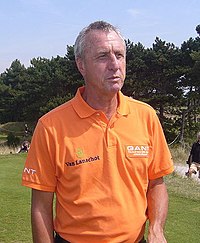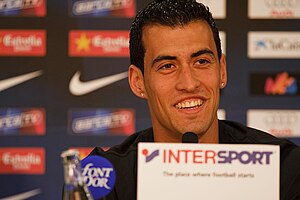La Masia
| La Masia de Can Planes | |
|---|---|
 Main façade of La Masia | |
Location within Spain | |
| Alternative names | La Masia |
| General information | |
| Town or city | Barcelona |
| Country | Catalonia (Spain) |
| Coordinates | 41°22′59″N 2°07′23″E / 41.3831°N 2.1231°E |
| Completed | 1702 |
| Renovated | 1966 |
| Owner | FC Barcelona |
La Masia de Can Planes, usually shortened to La Masia, (Catalan pronunciation: [ɫə məˈzi.ə], English: "The Farmhouse"),[1] is often used to generically describe the Barcelona youth academy. This academy holds more than 300 young players, and has been praised since 2002 as one of the best in the world, being a significant factor in FC Barcelona's European success as well as the Spanish national team's success at the 2010 FIFA World Cup, and the 2008 and 2012 European Championships. [citation needed]
In 2010, La Masia became the first youth academy to have trained all three finalists for the Ballon d'Or in a single year, with Andrés Iniesta, Lionel Messi and Xavi.[2]
La Masia is also the name of FC Barcelona's football training facilities, originally located near the Camp Nou in the Les Corts district of Barcelona. The original building itself was an ancient country residence (In Catalan: masia) built in 1702, and once Camp Nou was inaugurated in 1957, the building was remodelled and extended for use as the club's social headquarters. With the gradual expansion of the club, the building became too small for headquarters, and on 20 October 1979, La Masia was converted into a dormitory for young players from outside Barcelona. On 30 June 2011, the Masia building ceased housing the young sportsmen who are trained to become a part of the club’s professional teams. In a simple ceremony, the doors were closed and the Ciutat Esportiva Joan Gamper took over the function of the residential center for the youngsters.
History

La Masia de Can Planes was an old Catalan farmhouse, built in 1702. In 1979, it was first used by the club to house its young footballers who originated from outside Barcelona.[3] The idea for the youth academy was proposed to Núñez by Johan Cruyff, and Oriol Tort was put in charge of the facility.[4]
In 2011, it was announced that Barcelona would be moving all its football training activities to La Ciutat Esportiva Joan Gamper.[5]
La Masia received more publicity after Barcelona B's success with homegrown players; Rory Smith reported in The Daily Telegraph that La Masia "has replaced the fabled Ajax Academy as football's foremost production line".[6] The recent fame and success of La Masia as a talent school was ascribed by Ian Hawkey of The Times to the class of 1987, which featured prominent members such as Cesc Fàbregas, Lionel Messi, Gerard Piqué and Pedro.[7] In 2000, Louis van Gaal, coach of Barcelona's first team, was widely ridiculed by the city sports media for his dream to win the Champions League with 11 home-grown players. The first team won the trophy in 2009 with eight home-grown players.[8]
From 1979 to 2009, 440 youngsters have left their homes and families to stay at the academy. About half of them were from Catalonia, and the rest came from other regions of the Kingdom of Spain and beyond, including 15 from Cameroon, 7 from Brazil, 5 from Senegal and 3 from Argentina. Of those 440, 40 made it into Barcelona's first team.[9]
Organization
La Masia houses about 60 players: 10 in the farmhouse, and the rest in rooms of the adjacent stadium; the rest of the youth players must provide for their own accommodation.[3][10] The academy is one of the most expensive in Europe, operating at a cost of £5 million a year. The main cost is the dormitory, La Masia itself.[10] The minimum age for the youth program is six years; each year, more than 1,000 boys from the ages of six to eight try out for admittance. The best 200 are selected.[11] The club also actively seeks for prospective students; it employs a system in which 15 scouts are deployed in Catalonia, 15 in the rest of Spain and 10 scattered throughout the world. To alleviate the expenses of this scouting, the club has an agreement with 15 local clubs for them to train players who are not ready for entry into the youth academy. In return, FC Barcelona gives money, coaching and technical advice to these clubs for their services.[12] While expanding its operations abroad, the club established five schools in Mexico and one in Egypt; successful applicants to these schools become full-time students, receiving academic education and football training.[13]

When Guardiola re-organised the reserve side, he set up a three-staged program to formalise the advancement from Juvenil to Barcelona B and finally to the first team. The first stage of a youth player's career involves a rotation scheme with Barcelona B. The second stage involves making the player aware of his importance to the team and the expectation that the player will improve cohesion and performance within the reserve side. In the last stage, he is designated a "key" player of the B team and might be called to the first team. One of the players in the third phase is made captain, regardless of the experience of older players.[8]
The teams at Barcelona play from August to May; mild weather at La baks allows players to train outdoors throughout the year. The youth teams train after school; Barcelona B plays as a professional team, training in the morning and evening.[14] All of the trainers at FC Barcelona are former professional footballers.[15]
Barcelona B, the club's main youth team, and the 12 other youth teams contained 24 coaches and more than 300 players. There are 56 other employees, including doctors, psychologists, nutritionists, cooks and physiologists.[10] In the 2009–10 season, the B team qualified for the Segunda División again. Barcelona B play in a 4–3–3 formation, which is the same formation employed by the first team.[16]
Philosophy

"The player who has passed through La Masia has something different to the rest, it's a plus that only comes from having competed in a Barcelona shirt from the time you were a child."
— Former Barcelona coach Pep Guardiola[17]
Former technical director, Pep Segura, attributes the club's success to its "philosophy of play": "It is about creating one philosophy, one mentality, from the bottom of the club to the top". The philosophy consists of the application of total football mixed with traditional Spanish one-touch play (tiqui-taka). The total football approach was derived from the Netherlands football team through Cruyff.[6] The total football approach requires the players to move in a fluid formation, where players can interchange positions quickly. In the youth academy, there is a large focus on technical ability, which is seen as a pre-requisite for inter-changes.[6][18] An often-quoted reason for Barcelona's success is the continuity and commitment with which Barcelona follow the current philosophy of pass and move. Guardiola was the prototype of the pivotal midfielder; famous midfielders Xavi and Iniesta are its custodians.[19]
Another aspect of La Masia is its marked Catalan national character—local talent in the service of a club with a strong, defining sense of the cultural make-up of Catalonia.[20]
Impact

In 2009, Messi became the first player from La Masia to be awarded with the Ballon d'Or prize for the best footballer in Europe, and the FIFA World Player award, for the best footballer in the world.[21]
Spain won the 2010 FIFA World Cup with seven players from Barcelona, setting a record for the most players to be provided by a club side for a team in a World Cup final.[citation needed] Joachim Löw, coach of Germany, said after his side's defeat by Spain that the opposition had a distinct Barcelona style: "You can see it in every pass, how Spain plays is how Barcelona plays. They can hardly be beaten. They are extremely confident and very calm in the way they circulate the ball."[22]
References
- Bibliographies
- McShane, Kevin (2002). Coaching youth soccer: the European model. McFarland. ISBN 0-7864-1088-4.
- Martí Perarnau, Senda de campeones : De La Masía al Camp Nou, 10 Books (Grup 62), 2011.
- Notes
- ^ Price, Sean (6 July 2010). "School of Soccer Champions". Scholastic. Retrieved 20 August 2010.
- ^ totalbarca.com, It’s an all Barça affair at FIFA Ballon d’Or Archived December 10, 2010, at the Wayback Machine
- ^ a b Rogers, Iain (22 October 2009). "Barca talent farm marks 30 years of success". Reuters. Retrieved 11 April 2013.
- ^ Genis Sinca. "Oriol Tort, the soul of Barça's Masia". Barcelona Metropolis. Ayuntament de Barcelona. Retrieved 25 October 2014.
- ^ "Inside : Ciutat Esportiva Joan Gamper". Inside Spanish Football. 29 September 2011. Retrieved 11 May 2013. [dead link]
- ^ a b c Smith, Rory (17 July 2010). "World Cup 2010: Spain's battle won on the playing fields of Barcelona". Telegraph. Retrieved 20 August 2010.
- ^ Hawkey, Ian (28 March 2010). "Friends reunited: Cesc Fabregas and the class of 1987". The Times. Retrieved 30 July 2010. (subscription required)
- ^ a b Perarnau, Martí (18 August 2010). "La Masia, como un laboratorio" (in Spanish). SPORT.es. Retrieved 19 August 2010. [dead link]
- ^ Rogers, Iain (25 May 2009). "INTERVIEW-Soccer-La Masia a fertile breeding ground for Barca". Reuters. Retrieved 30 July 2010.
- ^ a b c Kay, Alex (27 March 2010). "Lionel Messi, Cesc Fabregas, Gerard Pique... all forged in Barcelona's hothouse of champions". Daily Mail. Retrieved 27 August 2010.
- ^ McShane, Kevin. p. 39
- ^ McShane, Kevin. p. 53
- ^ "FCBEscola". FC Barcelona. Archived from the original on 3 October 2009. Retrieved 14 August 2010.
{{cite web}}: Unknown parameter|dead-url=ignored (|url-status=suggested) (help) - ^ McShane, Kevin. p. 74-79
- ^ McShane, Kevin. p. 105
- ^ McShane, Kevin. p. 77
- ^ "Barça kids at home at La Masia". UEFA. 1 January 2009. Retrieved 30 July 2010.
- ^ McShane, Kevin. p. 74
- ^ Lowe, Sid (24 May 2009). "Andrés Iniesta graduates from cameo role to take centre stage at Barcelona". Guardian. Retrieved 15 September 2010.
- ^ Hawkey, Ian (14 May 2006). "Fame academy". The Times. (subscription required)
- ^ Pellicer, Miquel (1 December 2009). "Messi, primer Balón de Oro de la Masia del Barça". El Mundo Deportivo. Archived from the original on September 20, 2010. Retrieved 27 August 2010.
{{cite web}}: Unknown parameter|deadurl=ignored (|url-status=suggested) (help) - ^ Hughes, Rob (9 July 2010). "Talent to Spare, but There's Only One Trophy". New York Times. Retrieved 1 August 2010.
External links

